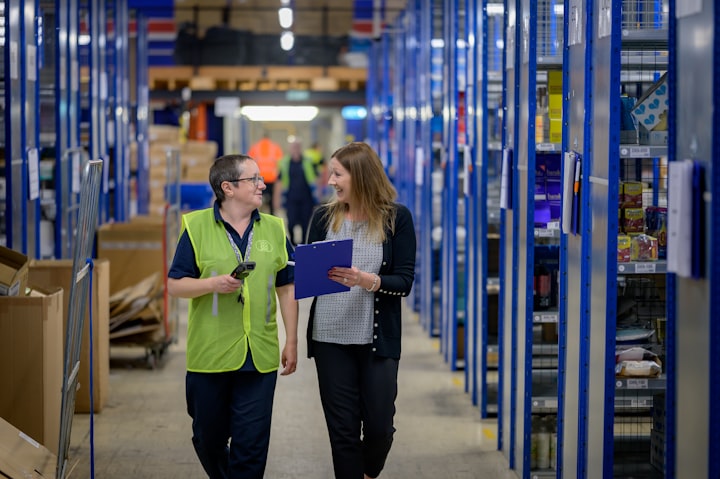How Warehouse Automation Can Streamline Your Business
Warehouse Automation for Business

Maintaining a warehouse daily can consume a lot of time and resources. As an emerging and established business, warehousing is still one area many companies overlook. Thus, this can lead to a detrimental effect on the supply chain and inventory and lost sales, shipping delays, or other financial losses.
What is the ideal solution here?
Well, this is where the Warehouse automation solution comes into the picture. As soon as you have this technology at your fingertips, you can fundamentally alter your warehouse operations - in a positive way!
As per the reports, global smart warehousing market size is expected to surpass $25.4 billion by 2026, representing a CAGR of 11.5% for the forecast period from now until then.
Modern technology and innovation have enabled us to implement warehousing practices that increase efficiency and enhance operations like never before.
Do you still need to determine whether intelligent warehouse automation can help you grow? Don’t worry. Continue reading to learn how warehouse software solutions can benefit you.
What is a Smart Warehouse?
The term smart warehouse refers to a warehouse that has implemented several technology solutions to improve productivity, accuracy, and efficiency. By implementing this process, the operation can gain additional capabilities, be more flexible, have fewer errors, and provide better service to the customer.
Manual warehouses have workers moving around with task lists, storing items away, picking products, packing them for shipping, and delivering them. Smart warehouse management solutions automate and integrate different parts of this process.
What are the top Ways to Make Your Warehouse Smarter?
Business owners can benefit from smart warehouses in a variety of ways. However, it should improve your efficiency and results. Listed below are five ways through which warehouse automation can transform the way to operate warehouses and manage inventory.
Warehouse Management System (WMS)
Almost all intelligent warehousing systems rely on a warehouse management system (WMS). With the help of a WMS, you can keep track of the day-to-day operations of your warehouse in the cloud, allowing you to track how they are going. It includes modules that will help you track inventory, pick, pack, ship, and more.
WMS technology solutions can be required to make your warehouse more efficient by reducing order fulfillment times since it can view order activity more closely, and the entire inventory and logistic system will be more transparent.
Automated Picking Tools
A large warehouse's order-picking process can be highly time-consuming and error-prone. The picking process in high-volume warehouses can benefit from warehouse automation so that the labor involved in the operation can be reduced.
Some valuable benefits of automated warehouse picking solutions include reducing or eliminating the number of walking workers have to do and improving order picking accuracy.
Automated Guided Vehicles (AGVs)
AGVs are an effective method of accelerating your process of storing and retrieving goods and assisting in the putaway, loading, and stocktaking of goods. Self-guiding AGVs can be equipped with forklifts and pallet carts, which can follow their digital path through the warehouse as they load and unload pallets, boxes, and other containers with their guidance.
AGVs can be installed in your warehouse without requiring you to re-think the layout and systems related to your warehouse and can be added to and expanded as needed, depending on the growth of your business in line with your growth strategy.
Using data to prevent inventory and storage errors
Without the implementation of technology in warehouse processes, errors will likely occur. When doing manual scanning, all kinds of mistakes can occur, from incorrectly placed items on an assembly line, incorrectly placed items in a truck when they are being transported, and missing items when certain items are manually scanned.
In the warehouse, forklift drivers often arrive with assets, and as soon as they arrive, they look for the right location for them to be placed. But once the assets are placed, the shelves are full since someone had forgotten to do the booking scan, which caused an inventory error to occur.
Platforms for automated inventory control
Do you use a specific system or application for logging inventory, counting cycles, and taking stock? Currently, or years in the past, you might be using pen and paper in these processes, so now is the time to move toward automation.
Despite being tried and tested, this data collection method is notorious for errors in data, transcription, and consistency, causing a great deal of disruption to your daily tasks.
With an inventory control platform with the appropriate use of asset tags and inventory tags, these platforms can automate stock counting, providing accurate real-time and remote access to reports like real-time stock counts and report synthesis.
Insights into smart warehouses: Key Features
Various types of interconnected technologies are used in smart warehouse systems to improve their efficiency. Several of the essential features of a smart warehouse are highlighted below in case you are considering implementing some of these solutions to improve your results:
Agile Warehouse Management
The warehousing industry has become much more complex in recent years than just a few years ago. Due to supply chain troubles, organizations have had to pivot and find ways to manage labor issues and the pressures of growth and expansion. Warehouse solutions designed for smart warehousing are flexible because they can be easily integrated with various sales and distribution platforms and other warehousing functions.
Warehouse Scalability
Due to the rapid growth of eCommerce, there is also an increasing need for more warehouse space and logistics capabilities since the sector is continuing to grow at an astounding rate. To ensure that companies can adapt quickly to seasonal or other growth factors, innovative warehouse solutions should be easily scalable for operations to continue as normal.
Warehouse Visibility
Now that the supply chain faces many issues and warehouse operations are becoming more complex, data visibility has become essential. A warehouse owner seeks to provide real-time information about products, and a customer seeks to provide the same information about their orders. As a result of the smart warehouse, these interested parties now have access to various information that can assist them.
Conclusion
Technology is progressing rapidly in all sectors of the economy at the moment. For warehouses to keep up with orders and cope with the demands of consumers and business partners, they must be equipped with solutions that enable them to do so. The right wms technology solutions can assist you in achieving the efficiencies and cost savings you need without having to design a complete warehouse re-design.
About the Creator
Albert Smith
Albert Smith is a digital marketing manager with Hidden Brains, a leading enterprise web & mobile app development company specializing in mobile & web applications, IoT, cloud and big data services.






Comments
There are no comments for this story
Be the first to respond and start the conversation.